Home > Information > press release > First National Project Using 8K Super Hi-Vision Technology for Medical Applications Start of Efforts toward the Practical Realization of a Laparoscopic Surgery System
First National Project Using 8K Super Hi-Vision Technology for Medical Applications Start of Efforts toward the Practical Realization of a Laparoscopic Surgery System
November 15, 2016
National Cancer Center
NHK Engineering System, Inc.
Olympus Corporation
NTT Data Institute of Management Consulting, Inc.
in Japanese
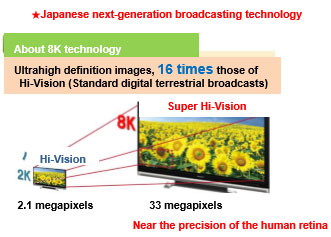
having 16 times the resolution of the conventional Hi-Vision format. This level of definition is said to be near the precision of the human retina. This research is the first attempt to use 8K technology, which is Japanese next-generation broadcasting technology in medical instruments. Practical realization of this technology may allow cancer surgery to be performed more precisely and delicately, enhance the safety and curability of laparoscopic and other endoscopic surgery, and have a positive impact on the medical economy. For these reasons, expectations are high that the national project could prompt a major transformation of medical settings.
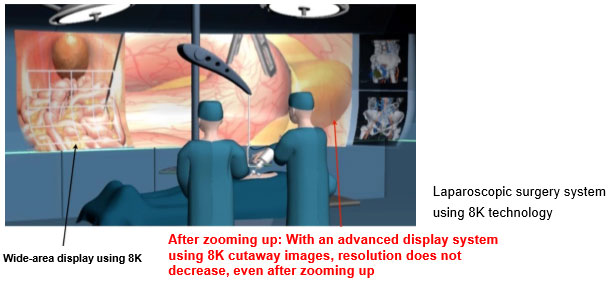
Background
In recent years, the number of instances of laparoscopic surgery have been increasing rapidly. As this type of surgery is conducted while viewing images on a monitor, image quality can affect the quality of surgery, leading to limitations in surgical operation and blind spots that prevent this type of surgery from having the same quality as laparotomies. In addition, intraoperative complications may occur. For example, the field of vision of conventional laparoscopes is small, making it difficult to check internal areas. This creates the risk of collisions between laparoscopes and surrounding surgical instruments and reportedly doubles instances of intraoperative organ damage, compared with laparotomies (JCOG0404 study).To resolve issues such as these, this project aims for improved optical performance and further enhancements in camera sensitivity, as well as making cameras smaller and more lightweight. In addition, the project will work toward technological developments using 8K wide-area displays and let give operators control zoomed-up images at will.
Also, non-Japanese companies have an overwhelming share of the market for medical instruments, but 8K technology was developed in Japan by NHK. This joint undertaking among the National Cancer Center, which provides medical services and conducts research; NHK Engineering System and Olympus, which develops 8K laparoscopic surgery systems; and NTT Data Management Consulting, which analyzes data, may lead to the establishment of global next-generation laparoscopic standards, including the development of peripheral equipment and new diagnostic methods that use high-precision image data.
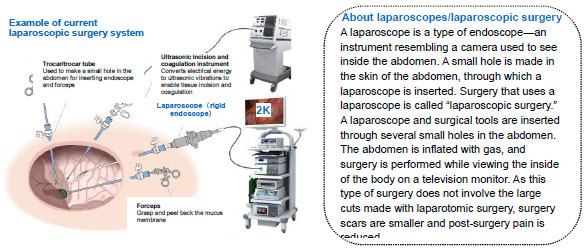
Development Issues and Objectives
The project team is addressing the following issues in the aim of developing and achieving practical realization and popularizing a new laparoscopic surgery system using 8K technology.- Improve the optical performance of rigid endoscopes
- Further increase the sensitivity of 8K cameras and make them more compact and lightweight
- Develop a high-intensity light source that emits little heat
- Develop lightweight adapters that connect easily to rigid endoscopes
- Develop new technology for making it easy to get specific cutaways of images having a narrow viewing angle in line with the operator’s intended scope and position so that these electronically zoomed 8K images can be used in the surgical field in the same manner as wide-angle 8K images.
- Develop a high-definition video database by case, as well as new diagnostic methods employing high-resolution data
By making a database by cases that combine images of organs taken within the abdominal cavity and observation photos of carcinoma microstructures, as well as the results of pathological analysis on specimens that have actually been resected, and obtaining objective technical evaluation and advice from the Japan Society for Endoscopic Surgery, we will consider their application toward the development of new diagnostic methods.
By fiscal 2018, we intend to come up with specific plans for practical realization and popularization, and to summarize medical utility based on accumulated data, as well as data sharing and utility between hospitals.
Expectations of Practical Realization
- Increase cancer curability (cure rate)
- By applying ultrahigh-definition 8K technology to laparoscopic surgery, we expect to generate an ultrarealistic feeling incomparable to that possible with conventional endoscopes and enable increasingly precise surgery allowing for the appropriate resection of lesions and lymph nodes in cancerous areas. Through surgery with ultrahigh definition that exceeds laparotomy, it is anticipated that curability will be increased, leading to the curing of more cases.
- Highly accurate surgery that makes ample use of ultrahigh-definition and wide-area video characteristics may also be possible in surgeries related to autonomic nerves that cannot be seen with the naked eye. It is expected that the technology may be used to enhance function preservations, such as urination and sexual function.
- By applying the high-resolution performance of 8K cameras to the overall surgical field and developing systems that allow areas around surgical sites to be viewed simultaneously, it is expected that wider surgical areas will become visible, avoiding apparent and unapparent intraoperative organ damage, thereby reducing complications.
- Contribute to the medical economy
- Increasing the cure rate should lead to a decrease in the number of patients requiring expensive drug treatment therapies including molecularly targeted drugs following relapse. In addition, reducing complications should lead to shorter postoperative hospital stays.
- As the practical realization of camera stands will make it unnecessary for a surgeon to hold the camera stand, the number of surgeons necessary for procedures will be reduced from the conventional three to two. This should lead to higher levels of medical care in locations plagued with a serious shortage of surgeons and contribute to regional medicine.
- Configure an intelligent database (establish new diagnostics)
- Using an 8K endoscope system and ultrahigh-definition image information database should enable the observation of carcinoma microstructures that could not be perceived in the past, making new image diagnosis possible. In addition, using artificial intelligence based on new image diagnostics, it may be possible to combine real-time diagnostic aid information with endoscope images to determine optimal surgical approaches, identify groups of high recurrence risk, and reduce the overlooking of lesions, leading to the development of effective treatment methods.
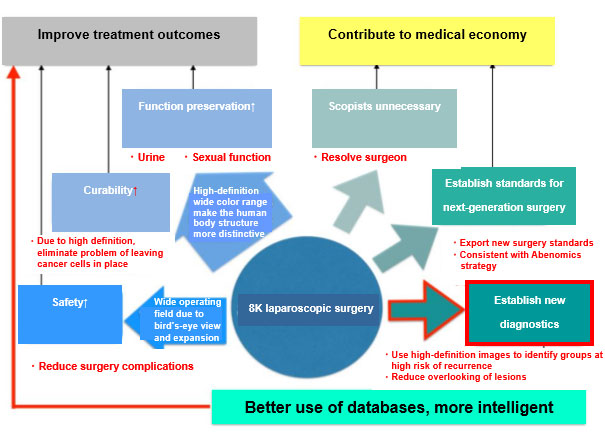
Research Expenses
Japan Agency for Medical Research and DevelopmentSubject: “Development of a New Endoscopic (Rigid Endoscope) Surgery System Using 8K Super Hi-Vision Technology and the Use of High-Precision Image Data”
Leader: Yukihide Kanemitsu, Chief of Colorectal Surgery, National Cancer Center Hospital
Reference
Ministry of Internal Affairs and Communications: Study Group on Medical Intelligence Building with 8K Technology Applied
http://www.soumu.go.jp/menu_news/s-news/02ryutsu02_03000261.html (Japanese only)
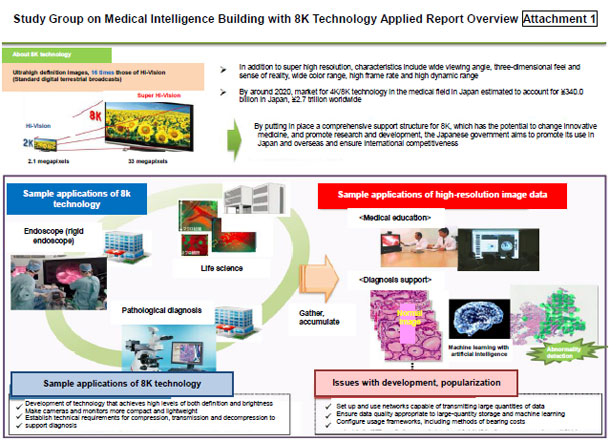
Press release
Media Inquiries
Office of Public Relations, Strategic Planning
Bureau National Cancer Center
5-1-1 Tsukiji, Chuo-ku, Tokyo 104-0045
Tel: +81-3-3542-2511(main)
E-mail: ncc-admin[at]ncc.go.jp (Please replace [at] to @.)
Planning and Development Promotion Division
NHK Engineering System, Inc.
1-10-11 Kinuta, Setagaya-ku Tokyo 157-8540
Tel: +81-3-5494-2400
E-mail: nes-plan[at]nes.or.jp (Please replace [at] to @.)
Public Relations Manager
Corporate Planning Division
NTT Data Institute of Management Consulting, Inc.
Tel: +81-3-5213-4016 (main)
